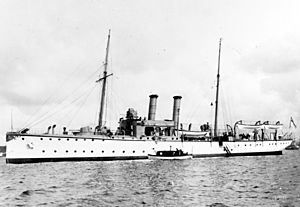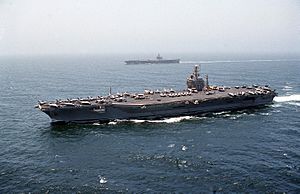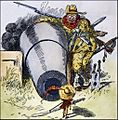Gunboat diplomacy facts for kids
Gunboat diplomacy is when a country uses its powerful navy to get what it wants from another country. It means showing off naval strength to make a point or threaten war, without actually starting a fight. The goal is to make the other country agree to certain terms because they see the superior military force.
Contents
What is Gunboat Diplomacy?

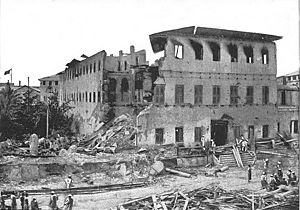
The idea of gunboat diplomacy started in the 1800s. During this time, powerful countries in Europe and the United States wanted to expand their influence. They would send their warships, like gunboats, to the coast of less powerful nations. The sight of these strong ships was often enough to scare the other country into agreeing to demands. It usually meant they didn't even need to fire a shot.
One famous example happened in 1850. A British citizen named David Pacifico was attacked in Athens, Greece. The Greek government didn't pay him back for the damage. So, the British Foreign Secretary, Lord Palmerston, sent a group of Royal Navy ships to block the port of Piraeus. This show of force made the Greek government pay up.
Having a strong navy allowed powerful nations to set up military bases and create good trade deals around the world. Besides taking over lands, gunboat diplomacy was a main way to find new trade partners and expand empires. Countries without strong navies often found their peaceful relationships broken. They ended up relying on the powerful nations for resources and markets.
A diplomat and naval expert named James Cable explained gunboat diplomacy in detail. He said it's "the use or threat of limited naval force, not as an act of war, to gain an advantage or avoid a loss." He also said it could be used to solve international problems or deal with foreign people in another country.
Cable divided gunboat diplomacy into four main types:
- Definitive Force: Using naval power to make something happen or stop something from happening.
- Purposeful Force: Using naval power to change what a government or group is doing.
- Catalytic Force: Using naval power to gain time or give leaders more choices.
- Expressive Force: Using navies to send a political message. This is about showing power without direct action.
Gunboat Diplomacy Today
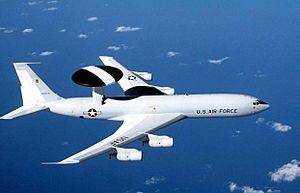
Gunboat diplomacy is still used today, especially by the United States. The U.S. has a very powerful navy. American leaders often move their large naval fleets around the world to influence other countries.
For example, during the Yugoslav Wars in the 1990s, the U.S. used sea-launched Tomahawk missiles. They also used E-3 AWACS surveillance planes to show their military presence. Henry Kissinger, a former U.S. Secretary of State, once said, "An aircraft carrier is 100,000 tons of diplomacy." This means that just having a huge aircraft carrier nearby can be a powerful diplomatic tool.
Key Historical Examples
Here are some important times when gunboat diplomacy was used:
18th Century Examples
19th Century Examples
- Second Barbary War (1815)
- Pastry War (1838–39)
- Don Pacifico Incident (1850)
- Opening of Japan by U.S. Navy Commodore Matthew C. Perry and his Black Ships (1853–54)
- Shimonoseki Campaign (1863–1864)
- Shinmiyangyo in Korea (1871)
- Anglo-Zanzibar War (1896)
- Yangtze River Patrol (1850s–1930s)
20th Century Examples
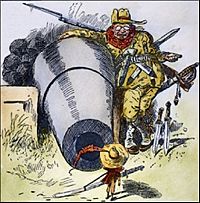
- Venezuela Crisis of 1902–1903
- Panama separating from Colombia
- Great White Fleet (1907)
- Agadir Crisis (1911)
- Occupation of Veracruz (1914)
- First Taiwan Strait Crisis (1954–55)
- Third Taiwan Strait Crisis (1995–96)
21st Century Examples
- Spratly Islands dispute
Images for kids
-
William Allen Rogers's 1904 cartoon shows Theodore Roosevelt's "big stick diplomacy" like a scene from Gulliver's Travels.
-
Damage to the palace in Zanzibar after British warships attacked in 1896. The Anglo-Zanzibar War was very short.
-
An E-3 AWACS aircraft, used for surveillance and radar, often part of modern gunboat diplomacy.
-
A 1903 cartoon showing President Theodore Roosevelt using his power to get the Panama Canal Zone from Colombia.
See also
 In Spanish: Diplomacia de cañonero para niños
In Spanish: Diplomacia de cañonero para niños


